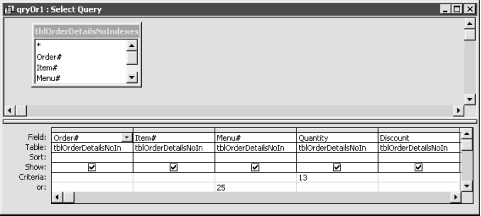Use Rushmore to Speed Up Queries
Problem
You’ve heard that Rushmore can improve the performance of your queries. How do you create queries that use Rushmore?
Solution
Rushmore query optimizations help the Jet engine (the database engine built into Access) execute certain types of queries dramatically faster. This solution explains how Rushmore works and how you can take advantage of it. It also introduces a technique for timing the execution of queries.
Load the
08-04.MDB database. Open the qryOr1 query in
design view. This query, which is shown in Figure 8-11, contains criteria on two fields, Menu# and
Quantity. It returns all records from tblOrderDetailsNoIndexes where
Quantity = 13 or where Menu# = 25. If you switch to SQL view,
you’ll see the following Where clause:
WHERE (((tblOrderDetailsNoIndexes.[Quantity])=13)) OR (((tblOrderDetailsNoIndexes. [Menu#])=25))
Close the query and open the tblOrderDetailsNoIndexes table to confirm that this table has no indexes. The qryOr2 and qryOr3 queries are identical to qryOr1, but they are based on different tables. qryOr2 is based on tblOrderDetailsPartialIndexed, which contains an index on the Menu# field, and qryOr3 is based on tblOrderDetailsFullyIndexed, which contains indexes for both Menu# and Quantity.

Figure 8-11. The qryOr1 returns rows where Quantity = 13 or Menu# = 25
Run the three queries in turn. You should notice that qryOr3 ...
Get Access Cookbook now with the O’Reilly learning platform.
O’Reilly members experience books, live events, courses curated by job role, and more from O’Reilly and nearly 200 top publishers.

